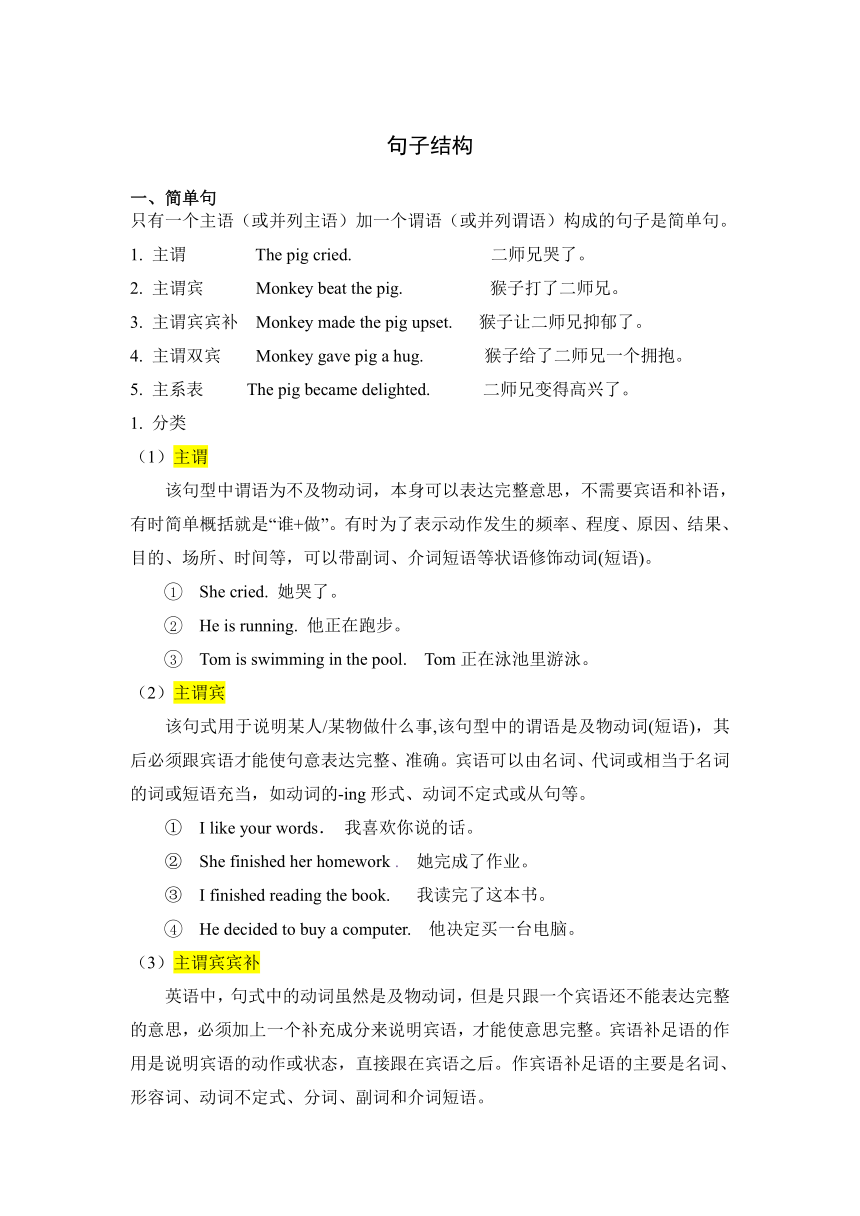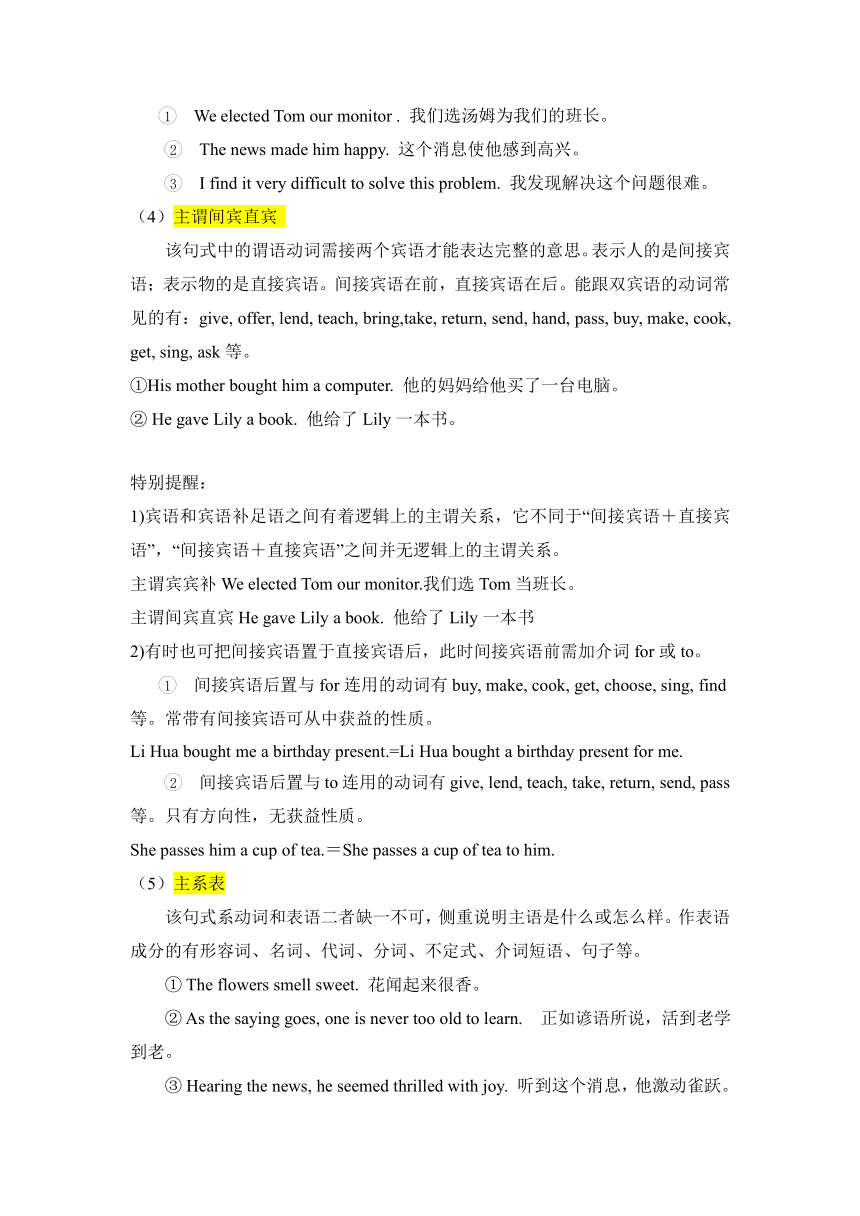高一英语初升高衔接复习(句子结构)讲义
图片预览


文档简介
句子结构
简单句
只有一个主语(或并列主语)加一个谓语(或并列谓语)构成的句子是简单句。
1. 主谓 The pig cried. 二师兄哭了。
2. 主谓宾 Monkey beat the pig. 猴子打了二师兄。
3. 主谓宾宾补 Monkey made the pig upset. 猴子让二师兄抑郁了。
4. 主谓双宾 Monkey gave pig a hug. 猴子给了二师兄一个拥抱。
5. 主系表 The pig became delighted. 二师兄变得高兴了。
1. 分类
(1)主谓
该句型中谓语为不及物动词,本身可以表达完整意思,不需要宾语和补语,有时简单概括就是“谁+做”。有时为了表示动作发生的频率、程度、原因、结果、目的、场所、时间等,可以带副词、介词短语等状语修饰动词(短语)。
She cried. 她哭了。
He is running. 他正在跑步。
Tom is swimming in the pool. Tom正在泳池里游泳。
(2)主谓宾
该句式用于说明某人/某物做什么事,该句型中的谓语是及物动词(短语),其后必须跟宾语才能使句意表达完整、准确。宾语可以由名词、代词或相当于名词的词或短语充当,如动词的 ing形式、动词不定式或从句等。
① I like your words. 我喜欢你说的话。
② She finished her homework . 她完成了作业。
③ I finished reading the book. 我读完了这本书。
He decided to buy a computer. 他决定买一台电脑。
(3)主谓宾宾补
英语中,句式中的动词虽然是及物动词,但是只跟一个宾语还不能表达完整的意思,必须加上一个补充成分来说明宾语,才能使意思完整。宾语补足语的作用是说明宾语的动作或状态,直接跟在宾语之后。作宾语补足语的主要是名词、形容词、动词不定式、分词、副词和介词短语。
We elected Tom our monitor . 我们选汤姆为我们的班长。
The news made him happy. 这个消息使他感到高兴。
I find it very difficult to solve this problem. 我发现解决这个问题很难。
(4)主谓间宾直宾
该句式中的谓语动词需接两个宾语才能表达完整的意思。表示人的是间接宾语;表示物的是直接宾语。间接宾语在前,直接宾语在后。能跟双宾语的动词常见的有:give, offer, lend, teach, bring,take, return, send, hand, pass, buy, make, cook, get, sing, ask等。
①His mother bought him a computer. 他的妈妈给他买了一台电脑。
② He gave Lily a book. 他给了Lily一本书。
特别提醒:
1)宾语和宾语补足语之间有着逻辑上的主谓关系,它不同于“间接宾语+直接宾语”,“间接宾语+直接宾语”之间并无逻辑上的主谓关系。
主谓宾宾补We elected Tom our monitor.我们选Tom当班长。
主谓间宾直宾He gave Lily a book. 他给了Lily一本书
2)有时也可把间接宾语置于直接宾语后,此时间接宾语前需加介词for或to。
间接宾语后置与for连用的动词有buy, make, cook, get, choose, sing, find等。常带有间接宾语可从中获益的性质。
Li Hua bought me a birthday present.=Li Hua bought a birthday present for me.
间接宾语后置与to连用的动词有give, lend, teach, take, return, send, pass等。只有方向性,无获益性质。
She passes him a cup of tea.=She passes a cup of tea to him.
(5)主系表
该句式系动词和表语二者缺一不可,侧重说明主语是什么或怎么样。作表语成分的有形容词、名词、代词、分词、不定式、介词短语、句子等。
① The flowers smell sweet. 花闻起来很香。
② As the saying goes, one is never too old to learn. 正如谚语所说,活到老学到老。
③ Hearing the news, he seemed thrilled with joy. 听到这个消息,他激动雀跃。
④We feel comfortable in school uniform every day.每天我们穿着校服感到很轻松。
并列句
定义:两个或两个以上的简单句用并列连词或标点符号(一般是分号;)连接而成的句子叫并列句。
并列句的构成方式:用连接词连接,前面可加逗号;或者是用分号“;”连接。例:
These flowers are white and those flowers are red.
We fished all day, but we didn't catch a thing.
I found a bucket, put it in the sink, and turned the tap on.
I took off my coat, searched all my pockets, but couldn't find my key.
We fished all day; we didn't catch a thing.
Hurry up; it's getting late.
并列句的分类:
(1)表示顺承和递进,连接两个同等概念,常用and, not only…but also…, neither…nor…, then等连接。
The teacher’s name is Smith, and the student’s name is John.
(2)表示选择,常用的连词有or, either…or…, otherwise等。
I like to watch TV or play games in my free time.
Hurry up, or you’ll miss the train.
(3)表示转折,常用的连词有but, yet, while,still, however, nevertheless等。
Someone borrowed my pen, but I don’t remember who.
He was feeling very ill. However, he still went to school.
表示因果关系,常用的连词有so, for, therefore等。
He was late for school because he got up late.
He got up late so he was late for school.
特别提醒:当几个分句并列时,如果它们之间都是并列关系,只在最后两个分句之间加并列连词and,其余分句用逗号隔开,即:“A, B, C and D”结构;如果分句之间关系各异,则需要分别加并列连词。
例:The suit is new and I like its color and style but it doesn't fit me, so I can't buy it.
练一练: 找出并列连词并说明该句子属于哪一类并列关系。
Neither is he mistaken, nor am I.
She not only finished her homework, but (also) washed her clothes.
We love peace but we are not afraid of war.
He worked hard, yet he failed.
The news may be unexpected; nevertheless it is true.
Put on your coat, or you'll catch a cold.
Start out right away, or/ otherwise you'll miss the first train.
It was late, so we went home.
We listened eagerly, because he brought news of our families.
复合句
复合句又称主从复合句,由一个主句和一个或一个以上的从句构成。主句为句子的主体,从句只用作句子的一个次要成分,不能独立成为一个句子。从句通常由关联词引导,并由关联词将从句和主句联系在一起。
复合句分类
(1)名词性从句
1)主语从句:作句子主语的从句叫主语从句。
主语从句可以由连词(that, whether)、连接代词(who, whom, whose,which, what, whatever, whoever,whichever等)、连接副词(when, where, how, why, whenever, wherever等)引导,且不能省略。
Who will go is not important.
谁将去并不重要。
宾语从句:用作宾语的从句叫做宾语从句。
可以是动词的宾语;可以是介词的宾语;也可以是形容词的宾语。
I don't know what he is talking about.
我不知道他在谈什么。
表语从句:用作表语的从句叫作表语从句,它位于主句中的连系动词之后。
常用的连接词有从属连词whether,that; 连接代词what,who, which等;连接副词 when, where等。此外,表语从句还可以用as if, as though, because等来引导。if不能引导表语从句。
The good new is that he passes the exam.好消息就是他通过考试了。
The fact is that he is one of the top three physicists in China.
事实是,在中国,他是三位顶尖的物理学家之一。
同位语从句: 用作同位语的从句叫同位语从句。
同位语从句往往用来说明某些名词的实际内容或对该名词作进一步的解释。常见的有fact, news, idea, truth, hope, problem, information, wish, suggestion, conclusion等。
He tells us the good new that he passed the exam.他告诉我们他通过考试的好消息。
The hope that he may recover is not lost yet.
他会康复的希望没有消失。
定语从句——在复合句中,修饰某一名词或代词的从句叫做定语从句。定语从句的作用相当于形容词,用来修饰主句中的某一名词或代词或整个主句,所以,也称作形容词性从句。
The man who is talking with my father is a policeman.
正和我父亲交谈的那个人是一个警察。
A dictionary is a book which gives the meaning of words.
词典是解释词语的书。
This is the place where I live. 这是我住的地方。
(3)状语从句——状语从句在句中起状语作用,修饰主句中的谓语动词、形容词或副词。一般分为九大类,分别表示时间、地点、原因、目的、结果、条件、让步、比较、方式。
You can tell me if you need help.
如果你需要帮助,你就告诉我。
Listen and be quiet while others are talking!
在别人说话时要听着,保持安静!
简单句
只有一个主语(或并列主语)加一个谓语(或并列谓语)构成的句子是简单句。
1. 主谓 The pig cried. 二师兄哭了。
2. 主谓宾 Monkey beat the pig. 猴子打了二师兄。
3. 主谓宾宾补 Monkey made the pig upset. 猴子让二师兄抑郁了。
4. 主谓双宾 Monkey gave pig a hug. 猴子给了二师兄一个拥抱。
5. 主系表 The pig became delighted. 二师兄变得高兴了。
1. 分类
(1)主谓
该句型中谓语为不及物动词,本身可以表达完整意思,不需要宾语和补语,有时简单概括就是“谁+做”。有时为了表示动作发生的频率、程度、原因、结果、目的、场所、时间等,可以带副词、介词短语等状语修饰动词(短语)。
She cried. 她哭了。
He is running. 他正在跑步。
Tom is swimming in the pool. Tom正在泳池里游泳。
(2)主谓宾
该句式用于说明某人/某物做什么事,该句型中的谓语是及物动词(短语),其后必须跟宾语才能使句意表达完整、准确。宾语可以由名词、代词或相当于名词的词或短语充当,如动词的 ing形式、动词不定式或从句等。
① I like your words. 我喜欢你说的话。
② She finished her homework . 她完成了作业。
③ I finished reading the book. 我读完了这本书。
He decided to buy a computer. 他决定买一台电脑。
(3)主谓宾宾补
英语中,句式中的动词虽然是及物动词,但是只跟一个宾语还不能表达完整的意思,必须加上一个补充成分来说明宾语,才能使意思完整。宾语补足语的作用是说明宾语的动作或状态,直接跟在宾语之后。作宾语补足语的主要是名词、形容词、动词不定式、分词、副词和介词短语。
We elected Tom our monitor . 我们选汤姆为我们的班长。
The news made him happy. 这个消息使他感到高兴。
I find it very difficult to solve this problem. 我发现解决这个问题很难。
(4)主谓间宾直宾
该句式中的谓语动词需接两个宾语才能表达完整的意思。表示人的是间接宾语;表示物的是直接宾语。间接宾语在前,直接宾语在后。能跟双宾语的动词常见的有:give, offer, lend, teach, bring,take, return, send, hand, pass, buy, make, cook, get, sing, ask等。
①His mother bought him a computer. 他的妈妈给他买了一台电脑。
② He gave Lily a book. 他给了Lily一本书。
特别提醒:
1)宾语和宾语补足语之间有着逻辑上的主谓关系,它不同于“间接宾语+直接宾语”,“间接宾语+直接宾语”之间并无逻辑上的主谓关系。
主谓宾宾补We elected Tom our monitor.我们选Tom当班长。
主谓间宾直宾He gave Lily a book. 他给了Lily一本书
2)有时也可把间接宾语置于直接宾语后,此时间接宾语前需加介词for或to。
间接宾语后置与for连用的动词有buy, make, cook, get, choose, sing, find等。常带有间接宾语可从中获益的性质。
Li Hua bought me a birthday present.=Li Hua bought a birthday present for me.
间接宾语后置与to连用的动词有give, lend, teach, take, return, send, pass等。只有方向性,无获益性质。
She passes him a cup of tea.=She passes a cup of tea to him.
(5)主系表
该句式系动词和表语二者缺一不可,侧重说明主语是什么或怎么样。作表语成分的有形容词、名词、代词、分词、不定式、介词短语、句子等。
① The flowers smell sweet. 花闻起来很香。
② As the saying goes, one is never too old to learn. 正如谚语所说,活到老学到老。
③ Hearing the news, he seemed thrilled with joy. 听到这个消息,他激动雀跃。
④We feel comfortable in school uniform every day.每天我们穿着校服感到很轻松。
并列句
定义:两个或两个以上的简单句用并列连词或标点符号(一般是分号;)连接而成的句子叫并列句。
并列句的构成方式:用连接词连接,前面可加逗号;或者是用分号“;”连接。例:
These flowers are white and those flowers are red.
We fished all day, but we didn't catch a thing.
I found a bucket, put it in the sink, and turned the tap on.
I took off my coat, searched all my pockets, but couldn't find my key.
We fished all day; we didn't catch a thing.
Hurry up; it's getting late.
并列句的分类:
(1)表示顺承和递进,连接两个同等概念,常用and, not only…but also…, neither…nor…, then等连接。
The teacher’s name is Smith, and the student’s name is John.
(2)表示选择,常用的连词有or, either…or…, otherwise等。
I like to watch TV or play games in my free time.
Hurry up, or you’ll miss the train.
(3)表示转折,常用的连词有but, yet, while,still, however, nevertheless等。
Someone borrowed my pen, but I don’t remember who.
He was feeling very ill. However, he still went to school.
表示因果关系,常用的连词有so, for, therefore等。
He was late for school because he got up late.
He got up late so he was late for school.
特别提醒:当几个分句并列时,如果它们之间都是并列关系,只在最后两个分句之间加并列连词and,其余分句用逗号隔开,即:“A, B, C and D”结构;如果分句之间关系各异,则需要分别加并列连词。
例:The suit is new and I like its color and style but it doesn't fit me, so I can't buy it.
练一练: 找出并列连词并说明该句子属于哪一类并列关系。
Neither is he mistaken, nor am I.
She not only finished her homework, but (also) washed her clothes.
We love peace but we are not afraid of war.
He worked hard, yet he failed.
The news may be unexpected; nevertheless it is true.
Put on your coat, or you'll catch a cold.
Start out right away, or/ otherwise you'll miss the first train.
It was late, so we went home.
We listened eagerly, because he brought news of our families.
复合句
复合句又称主从复合句,由一个主句和一个或一个以上的从句构成。主句为句子的主体,从句只用作句子的一个次要成分,不能独立成为一个句子。从句通常由关联词引导,并由关联词将从句和主句联系在一起。
复合句分类
(1)名词性从句
1)主语从句:作句子主语的从句叫主语从句。
主语从句可以由连词(that, whether)、连接代词(who, whom, whose,which, what, whatever, whoever,whichever等)、连接副词(when, where, how, why, whenever, wherever等)引导,且不能省略。
Who will go is not important.
谁将去并不重要。
宾语从句:用作宾语的从句叫做宾语从句。
可以是动词的宾语;可以是介词的宾语;也可以是形容词的宾语。
I don't know what he is talking about.
我不知道他在谈什么。
表语从句:用作表语的从句叫作表语从句,它位于主句中的连系动词之后。
常用的连接词有从属连词whether,that; 连接代词what,who, which等;连接副词 when, where等。此外,表语从句还可以用as if, as though, because等来引导。if不能引导表语从句。
The good new is that he passes the exam.好消息就是他通过考试了。
The fact is that he is one of the top three physicists in China.
事实是,在中国,他是三位顶尖的物理学家之一。
同位语从句: 用作同位语的从句叫同位语从句。
同位语从句往往用来说明某些名词的实际内容或对该名词作进一步的解释。常见的有fact, news, idea, truth, hope, problem, information, wish, suggestion, conclusion等。
He tells us the good new that he passed the exam.他告诉我们他通过考试的好消息。
The hope that he may recover is not lost yet.
他会康复的希望没有消失。
定语从句——在复合句中,修饰某一名词或代词的从句叫做定语从句。定语从句的作用相当于形容词,用来修饰主句中的某一名词或代词或整个主句,所以,也称作形容词性从句。
The man who is talking with my father is a policeman.
正和我父亲交谈的那个人是一个警察。
A dictionary is a book which gives the meaning of words.
词典是解释词语的书。
This is the place where I live. 这是我住的地方。
(3)状语从句——状语从句在句中起状语作用,修饰主句中的谓语动词、形容词或副词。一般分为九大类,分别表示时间、地点、原因、目的、结果、条件、让步、比较、方式。
You can tell me if you need help.
如果你需要帮助,你就告诉我。
Listen and be quiet while others are talking!
在别人说话时要听着,保持安静!
同课章节目录
